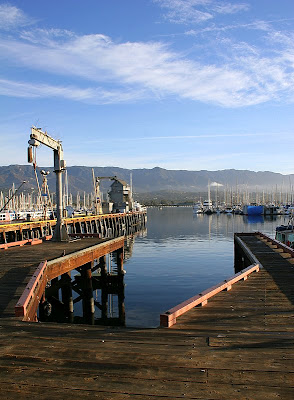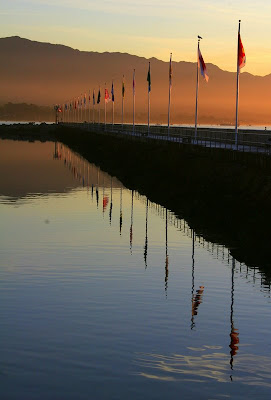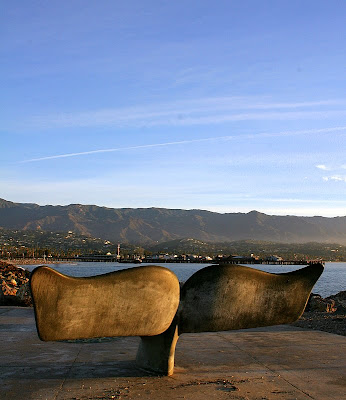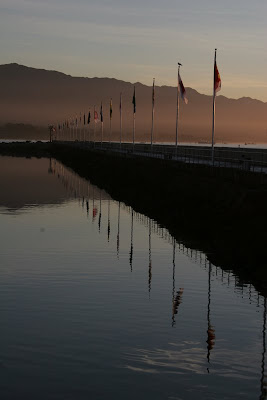
I've had some fun this morning!
My favorite type of photography has always been scenic and landscape photography--these are the photos that most inspire me to get out and shoot. There's an element of adventure to it that I really enjoy; getting outside in the early hours of the morning, waiting patiently for the light to be just right. It's something I've experienced only a few times, but the idea of it excites me.
Last night, I resolved to wake up early and go shoot something. I was excited, but I was also actually pretty nervous. I was sacrificing a good night's sleep for this--what if I got out there and didn't take a single worthwhile picture? If I go out there before sunrise, am I going to be able to see anything? What kinds of 'interesting' characters am I going to run into?

The sun rose at 6:30am, so I woke up at 6. That's probably not too early to a lot of you, but I typically go to bed between 11-12pm, and I need my eight hours to function. I had laid out my clothes and gear the night before, hoping to throw them on and head out. I ran into a few hiccups, though; I decided I needed some quick breakfast, and on my way out I got something in my eye / contact (my eyes are really dry in the morning) that had to be dealt with.
One of my intentions for this outing was to learn about the time around sunrise. When does it start getting light? If there are clouds, when are they lit up? When's the best light? I learned that at 6:00am, 30 minutes before sunrise, there's plenty of light outside for me to frame a shot with. I also learned as I headed out the door at 6:15 that the colors in the clouds happen just before sunrise... So I got to watch some gorgeous colors on my drive to the harbor, but they were about gone by the time I got there. That's ok, though, because not long after that, everything gets bathed in a beautiful warm light, and that's what I was really after this morning.
I'm calling this one "TIE Fighter" :)

Earlier this week I came across a great site full of good articles by a guy named Ken Rockwell. I particularly enjoyed his recent article on composition. This was my favorite part:
"In a nutshell, composition is all about balance. It's all about balance between light and dark, warm and cool, big and small, rhythm, pattern, line, curves, impact, negative space, texture and a lot more."
I've always understood composition as just the placement of objects and the lines and curves they form that lead your eye through the photo. But it's so much more than that! As he says, it's also about balancing the elements of the photo (I think another way to put that is that it's about contrast). What really excited me, too, was that I felt like I could recognize each of those elements of composition in his excellent photo at the top of the article. And hey, if I can recognize and appreciate them, I should be able to reproduce them!
I focused hard on these new elements of composition when I went out this morning. I especially tried to frame photos with both warm and cool tones, and to look for compositions with rhythm and pattern. Another point of advice Ken offered was not to let any lines "break the frame" (lead your eye out of it), and I think that helped me a lot.
This was my favorite of all of the shots.

Despite my efforts, I still ended up with a mixed bag of compositions ("mixed" being a generous term, as it implies half-and-half. Try one-in-ten). And some that I thought were really clever when I was shooting turned out to be garbage. I am proud to say, though, that there were a number of times where I framed a photo, thought hard about the composition, realized it was mediocre, and didn't press the button. That takes a lot of restraint! I bet one advantage to film photography is just that each shot is going to cost you x cents to process and print, so it better be worth it.
Ken also notes that a good way to test your composition is by looking at the thumbnail. If the thumbnail isn't interesting, then your composition's bad. I tried hard, but I failed to find a good composition for this whale tail bench.

There's actually a small sculpture right in front of it that's hard to keep out of the shot. I took a photo anyway, and the full-size image is pretty interesting because it's an interesting subject with good light. As a thumbnail, though, it becomes less enticing, and the problems with it become apparent.
The last thing I'll say about my outing was that when I got back, I was really disappointed with the images. The colors were very muddy, and the photos were not very sharp. With some editing, though, I was really pleased with the results. They were most in need of an increase in saturation.
I edited them in Picasa, and did the same handful of things, to varying degrees, that I did with the army jeep:
1. Crop
2. Auto-contrast
3. Saturation
4. Sharpen
Here's the before-and-after of the flags.













 If the histogram is bunched towards the left the image is going to look dark. If the histogram is really slammed up against the left side, a lot of pixels in your photo are showing up as 100% black and you've lost detail in the image. This means the exposure is too dark for the camera sensor to distinguish details in the shadows.
If the histogram is bunched towards the left the image is going to look dark. If the histogram is really slammed up against the left side, a lot of pixels in your photo are showing up as 100% black and you've lost detail in the image. This means the exposure is too dark for the camera sensor to distinguish details in the shadows.

















